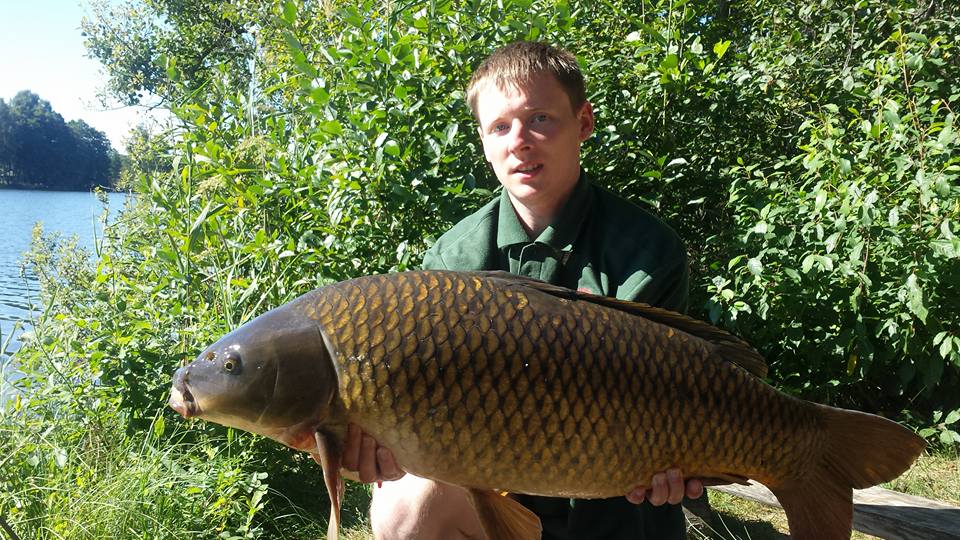The Common Carp’s History in North America
Cultivated as a food source in Eurasia for nearly 4,000 years. The Common Carp has been raised for thousands of years in Europe and China, was well known to the ancient Romans. Immigrants to the USA could not believe there were no carp in North America. Julius A. Poppe was one of the first (and most successful) to import carp to the US, cultivating a stock of five common carp imported from Germany in 1872 into a thriving California farm by 1876. U.S. Commission of Fish and Fisheries began an intensive effort of carp cultivation in 1877. By 1883, State Fish Commissions introduced carp to many area watersheds. By the turn of the century, the introduction of the carp was such a “success” that both public agencies and sportsmen had come to regard the fish as a nuisance. The rapid spread appeared to threaten both water quality and native species, as commissioners nationwide noted a deterioration of formerly clear and fertile lakes and waterways upon the arrival of carp. made a correlation – albeit the wrong one – between the rise of carp and the fall of game fish.
As the carp is both a prodigious reproducer and highly tolerant of pollution, it spreads quickly through waters in which most native species cannot live. In the early 1990s, for example, biologists exposed control groups of carp to 1600 chemicals commonly present in United States waters; only 135 of the pollutants killed all the fish.
A bottom-feeder, it roots along the floor of a body of water, frequently uprooting vegetation, and sucks in mud and other matter — after filtering out nutrients, it spits the restout. This increases the turbidity (muddiness) of water, which in turn reduces the ability of predator fish (such as pike or walleye) to see their prey. The amount of sunlight received by plants also decreases, reducing their growth — as plants disappear, so do the waterfowl which depend upon them for food. Carp can quickly crowd out other fish with sheer numbers, as well, as females lay up to 2 million eggs when spawning, and fry can grow as large as 8″ in the first year. Thus, the health of numerous small lakes and fisheries has suffered from the presence of the carp. However, the fish’s impact upon larger bodies of waters remains minimal when compared to that of human activity. Concentrated state efforts to permanently eliminate the fish by trapping, seining and poisoning were frequently undertaken early in the century. Few were entirely successful, however, as the carp was simply too adept at reproducing and thriving in our polluted waters. Conceding to the fish’s permanence, carp removal programs began in the 1950s to concentrate instead upon the control of carp populations and their migration into gamefish waters. Generations of anglers tried to remove carp and leave them on the banks, but this proved useless, and became illegal in states like Minnesota in the 80’s. A steady, or hopefully increasing, market for carp and carp products could today provide the prolonged check upon their population that State removal programs have been unable to due to limited resources. Most State agencies, in fact, have favored State-regulated commercial fishing to removal programs since the early 1980s.
Today, carp are viewed in many different ways and subject to varying opinions – depending on region, watershed and who you’re talking to. The decades old reputation as a “poor fighting trash fish” still hold true for many anglers around the country – but small pockets of carp enthusiasts are growing all over the nation. They continue to expand their range and are very harmful to many ecosystems – but they also fill voids in many watersheds where native species have disappeared due to pollution and habitat loss. Love them or hate them – one thing is clear – carp are here to stay. Their dominance in many watersheds, and their ability to tolerate a wide range of environments, leaves anglers with many questions the future of carp in North America.
Reproduction
- Males spawn at 3 years of age
- Batch spawner, releasing its adhesive eggs over vegetation
- Eggs hatch 3-4 days after fertilization
- Female carp can release up to 2 million eggs
Gamefish Facts
All tackle world record: 75 lbs, 11 oZ
Can live: up to 15 years
The species is tolerant to a wide range of environmental conditions
native to temperate Eurasia, boundaries of the native range are obscured by a long history of transplantation by humans now occupying every continent except Antarctica. Every US state but Alaska. The expanded range of Common Carp in the U.S. has occurred via numerous sources, including intentional stocking as food fish and ornamentals (for example, Koi), escapes from aquaculture facilities, use of juveniles as baitfish, and invasions of adjacent water-bodies by existing populations.
In 1653 Izaak Walton wrote in The Compleat Angler, “The Carp is the queen of rivers; a stately, a good, and a very subtle fish; that was not at first bred, nor hath been long in England, but is now naturalized.”
In Europe, even when not fished for food, they are eagerly sought by anglers, being considered highly prized coarse fish that are difficult to hook.
It is the fastest-growing angling market in the UK and has spawned a number of specialized carp angling publications such as Carpology,[29] Advanced carp fishing, Carpworld, and Total Carp, and informative carp angling websites, such as Carpfishing UK.
Carp are omnivorous, and their diet varies depending on what is available. hey consume a range of small food items such as molluscs, crustaceans, insect larvae and seeds. These food items are sucked up (along with mud and water) from the bottom and filtered out using the gill rakers.
Sources:
USGS, NPS.GOV, Wikipedia



